Parasites often prevent a person from living a normal life, as they greatly weaken the body. Representation of what parasites most often do in us, as well as how to deal with them - the article will be told.
Parasites are creatures that live and eat their hosts. They can inhabit all animals, fish, birds, and even humans. This causes a lot of problems, as these creatures damage health. Parasites in the human body can live in the liver, intestines, blood, and even attack the brain and lungs. What is the most common type? There are several different categories of parasites: flat and round worms, protozoa and insects. How they affect the body, and how to expel it - the article will tell.
Types of parasites
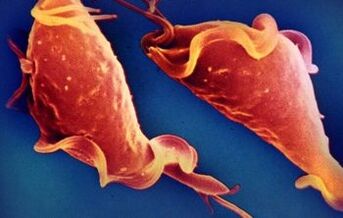
As already mentioned, there are various types of parasites in the human body:
- protozoa (trypanosome, plasmodium malaria, lamblia, amoebic dysentery);
- flatworms (cat fluke, liver fluke, bovine and pork tapeworm);
- ringworm (ringworm, cream worm);
- insects (lice, butterflies, fleas);
- chelicerae (hama).
This species most often attacks the human body. All united by the fact that they ate the juices and tissues of their host, slowly killing him. It is difficult to expel one of them, as each has many adhesive devices (suckers, hooks, chelicerae), and some even settle in the cells of the body, from which it is impossible to expel them.
Probably everyone knows about fleas, ticks and ticks, because these creatures live on the surface of the body, are easy to find, and a little easier to fight. But not everyone knows the internal parasites of the body, and in fact they are the most dangerous to health.
The easiest
These small organisms are found everywhere:
- in water;
- earth;
- the air.
It is impossible to see it, because it consists of only one cell. There are harmless representatives: ciliate shoes, proteus amoeba, green euglena and others. Some also help animals, for example, some ciliates digest cellulose from grass for cattle, but there are many parasites among these in abundance.
Plasmodium malaria
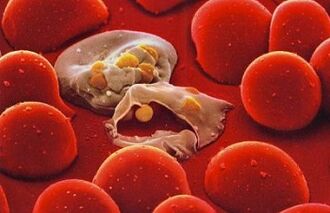
These Central Africans haunt many countries today. Plasmodium malaria is carried by mosquitoes of the genus Anopheles, which are not very picky, and the main ones for them are heat and water. Many countries do prevention of the disease: they drain the swamps, destroy the larvae, and the disease recedes there, but the parasite is still rampant in Central Africa and South America.
Once in the body, plasmodium malaria goes through two stages: hepatic and erythrocyte. The first passed after a few hours. Plasmodium attacks liver cells, gets into them, begins to multiply, and feeds on host nutrients. By this time, a person is already experiencing the first unpleasant symptoms:
- Headache;
- nausea;
- lack of appetite.
After a few days, the parasite leaves the liver into the bloodstream and settles on the red blood cells. He lived there a long time. Every 3-4 days he leaves one and enters the other. The way out is accompanied by the release of residual products of protozoa, therefore, the owner's temperature rises rapidly and strongly, fever, vomiting and intestinal disorders begin.
Treatment for Plasmodium malaria is difficult, because the parasite hides in host cells. When the main symptoms of the disease appear, it is necessary to call an ambulance and always give water to the patient before his arrival, because the temperature and fever cause dehydration. A type of plasmodium will be installed in the hospital (there are more than 5 of them), and treatment will be prescribed.
Prevention is simple - fence your residence with a mosquito net if there is an Anopheles mosquito breeding ground in the area, as well as drain the swamp or flood its surface in a special way that creates a film where mosquito larvae cannot breathe and die. .
Giardia and amenta dysentery
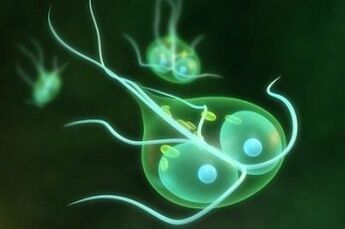
Both of these parasites live in the human digestive organs, and any animal can host them. They penetrate the body along with dirty water, unwashed fruits or vegetables. Their favorite places are the liver ducts, small intestine and upper part of the large intestine.
The symptoms don’t come long, and it’s hard not to notice. The first manifestation is a stool disorder. Over time, the temperature rises sharply, severe diarrhea and vomiting begin. Often, a person dies of dehydration, because the last two symptoms practically do not stop, the patient quickly loses water.
Fighting these parasites consists of drinking plenty of clean boiled water and taking a special salt packet - a preparation that contains a special salt composition that helps retain water in the body. Prevention is also simple - wash the product, monitor the condition of drinking water, because he is the source of reproduction of this parasite.
Average worm
Parasites in the human body can be unicellular and multicellular. This is a flat worm. The name comes from their shape, because they are really flat, because they breathe with the whole surface of the body, so they try to reduce the volume as much as possible. There are 3 types of flatworms: ciliates, flukes, and tapeworms. The first is harmless, they live on land or waters. But the second two classes are exclusively parasites.
Inhaler
This is a small worm that has a sucker on its mouth and stomach. They prefer to live in our bodies in the liver and gallbladder. These helminths have two main life phases - larvae and adults. The hosts of the larvae can be water mollusks (liver fluke), fish (cat fluke), but cattle and humans are permanent.
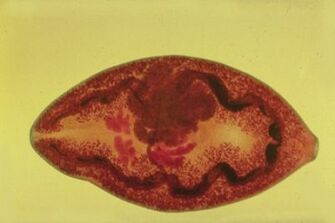
Adults most often settle in the liver area, but sometimes they can enter the intestines, lungs, and even the brain. Their accommodation includes:
- Headache;
- lose weight;
- lack of appetite;
- anemia.
They can only be killed by special anthelmintic drugs, which will be prescribed by a doctor, depending on the type of parasite.
The prevention is simple: do not drink water and do not swim in stagnant bodies of water, and also do not chew the grass in the field, as many people like to do, because the larvae of flatworms can also be in the grass.
Pita
Tapeworms are mentioned because these parasites are so long (except for echinococcus), that they actually look like tapeworms. They also thrive with a change of "place of residence", but often it is the people who become the permanent owners for them.
Pig and pig tapeworms attack the small intestine. They are attached with suction cups and hooks, so that they cannot be taken out of there by feces. They continue to grow, can reach a length of 10 meters or more. They can only be expelled from there with special drugs that will kill the parasite, the inhaler will rest, it will fall and come out with feces.
One of the most dangerous representatives of tapeworms is echinococcus. The larval nuclei are human and herbivorous, and adult worms settle on predators. This is a dangerous stage of parasitic larvae, because their structure is different from that of a tapeworm.
Echinococcal larvae are sacs in which many larvae develop. Such structures can attack the brain, lungs, intestines, liver. He is dangerous with his unrestrained growth, because sooner or later he just tears the tissue of his owner. If the echinococcus has invaded the brain or lungs, then only surgery can save the patient, but also dangerous.
If tapeworms have settled in our body, then we need to immediately go to the hospital, because they continue to grow, clog the intestines (tapeworms), affect the lungs or brain (echinococcus), drink all the essential juices and kill the host. Prevention consists of checking meat and fish for white or yellowish larvae. If there is, such a product should not be eaten!
Round worms
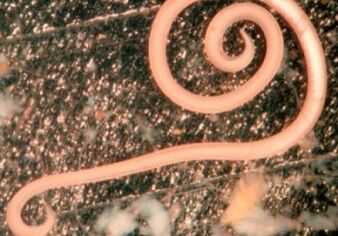
Many also hear of roundworms, as they poison people’s lives not infrequently than the flat ones, especially small children suffering from them. The most "famous" representatives are the ringworm and the cream worm, which inhabit the human intestine. Sometimes they can get into other organs: liver, eyes, brain.
Roundworms develop with habitat changes: larvae live in a person’s lungs, and adults in the gut. The name "round" characterizes their cross -sectional shape - they are completely round.
These worms do not have adhesive devices, but have muscles that help them hold feces. Sometimes they themselves crawl out of the body (cream worms) and lay eggs in the anus.
Children who suffer from them, because babies do not know the rules of hygiene, therefore, after combing the place of egg deposition, they can pull their fingers into their mouths and become infected again.
Treatment can be done with medications prescribed by a doctor. If the mother of a baby with crickets is afraid to give him pills, then you can cure him without them. To do this, it is necessary at 5-6 am (at this time the woman leaves the body and lays eggs around the anus) to clean the inside of the priest with vodka, and then lubricate the treatment area with baby cream so as not to dry out the delicate skin.
Prevention consists of the fact that you need to constantly monitor hygiene: wash your hands after touching the ground, do not drink dirty water.
Parasite test
If you have doubts about your own health, you can test for the presence of parasites in the body. If there are any of the following symptoms, put a plus sign.
- Weight loss was observed without diet or changes in diet.
- Temperatures are constantly rising in the region of 37-37. 5 grams.
- There is no appetite or, conversely, you always want to eat.
- There is always a desire to eat something sweet.
- Increased headache.
- Heat disadvantage.
- Disorders of feces.
- Nausea or vomiting
- Allergic rash or swelling.
- Pain in the liver and intestines.
- Fainting (if the brain is affected).
- Trembling hands.
- Persistent pallor.
If there are 1 to 4 pluses, then this means there are no worms, but the person is experiencing constant stress, pain or having problems with the digestive tract. If there are from 5 to 7 plus, then there is a suspicion of the presence of parasites, but more than 8 positive answers indicate the actual problem, so the urgent need to see a doctor.
Parasites poison the human body, weaken the immune system, prevent it from leading a normal active life, so you need to remember about the symptoms of their manifestation and methods of treatment, as well as preventive measures, because only then can you protect yourself and your family.
























